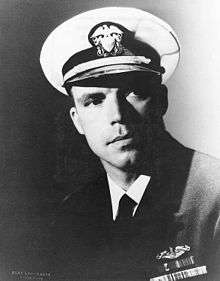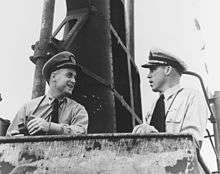Dudley W. Morton
Dudley Walker Morton (July 17, 1907 – October 11, 1943), nicknamed "Mushmouth" or "Mush", was a submarine commander of the United States Navy during World War II. He was commander of the USS Wahoo (SS-238) during its third through seventh patrols. Wahoo was one of the most-celebrated submarines of World War II, as it sank at least 19 Japanese ships, more than any other submarine of the time.[1] Morton and Wahoo disappeared in 1943 during a transit of La Pérouse Strait. He was legally declared deceased three years later.
Dudley Walker Morton | |
|---|---|
 Commander Dudley "Mush" Morton | |
| Nickname(s) | Mush |
| Born | July 17, 1907 Owensboro, Kentucky |
| Died | October 11, 1943 (aged 36) La Pérouse Strait |
| Allegiance | United States |
| Service/ | United States Navy |
| Years of service | 1927–1943 |
| Rank | Commander |
| Commands held | USS Wahoo (SS-238) USS Dolphin (SS-169) USS R-5 (SS-82) |
| Battles/wars | World War II |
| Awards | Navy Cross (4) Distinguished Service Cross Purple Heart |

Early life
Morton was born in Owensboro, Kentucky, on July 17, 1907. He graduated from the United States Naval Academy in 1930. There he received the nickname "Mushmouth", after a character in the cartoon strip Moon Mullins whose large square jaw and prominent mouth resembled Morton's. The nickname was shortened to "Mush", by which he was known for much of his life.
Naval career
Prior to the outbreak of World War II, Morton served in the USS Saratoga (CV-3), USS Chicago (CA-29), USS Canopus (AS-9), USS Fairfax (DD-93), and the submarines USS S-37 (SS-142) and USS R-5 (SS-82), which he commanded from August 19, 1940 to April 23, 1942. [2]
Morton was promoted to lieutenant commander on October 15, 1942, and was in nominal command of USS Dolphin (SS-169) while it underwent extended repairs at Pearl Harbor. He was relieved to make a war patrol in USS Wahoo (SS-238) between November 8 and December 26 as prospective commanding officer, a supernumerary position to prepare him for command of a fleet boat. Morton took command of Wahoo on December 31 in Brisbane, Australia. Between January 26, 1943 and October 11, he carried out four offensive patrols, during which Wahoo was responsible for sinking 19 cargo and transport ships for a combined total of 55,000 tons.
During Wahoo's third war patrol, Morton was responsible for an incident which resulted in shipwrecked soldiers in about twenty lifeboats[3] of sunken Japanese transport Buyo Maru[4] being fired on while in the water. The transport was torpedoed by Wahoo on 26 January 1943. Morton was responsible for ordering the machine gunning of the shipwrecked survivors in the water.[3][4][5] Morton and his executive officer, Richard O'Kane, had misidentified the survivors as solely Japanese. In fact, they were mainly Indian POWs of 2nd Battalion, 16th Punjab Regiment, plus escorting forces from the Japanese 26th Field Ordnance Depot.[6] Of 1,126 men aboard Buyo Maru, 195 Indians and 87 Japanese died in all, including those killed in the initial sinking.
This action is still considered controversial, since survivors in the water may have been shot at deliberately. O'Kane, who was on Wahoo's bridge when the incident took place, likened it to attacks on small craft made during the Dunkirk evacuation. He used the same pretense as the Germans did: to prevent the enemy from recovering soldiers that would shortly fight again.[5] However, the Hague Convention of 1907 bans the killing of shipwreck survivors under any circumstances.[7] O'Kane further explained that the fire from Wahoo was intended to force the troops to abandon their boats and no troops were deliberately targeted.[8] Vice Admiral Charles A. Lockwood, the contemporary COMSUBPAC who was also not present at the incident, asserted that the survivors were army troops and turned machinegun and rifle fire on Wahoo while she maneuvered on the surface. He further stated that such resistance was common in submarine warfare.[9] Later historian Clay Blair states Morton opened fire first and the shipwrecked returned fire with handguns.[10] This is regarded as a "simple war crime" by some while others believe it to be a crime that should have been punished.
Unlike German submariner Heinz-Wilhelm Eck, who was executed as a war criminal for ordering the killing of civilian shipwreck survivors, Morton did not face any criminal liability for his alleged actions. O'Kane believed this event prevented Morton from being awarded the Medal of Honor.[11]
After three arduous war patrols, Morton was given the highly dangerous assignment of penetrating the Sea of Japan for the second time. Morton was reported missing in action in December, when his submarine was presumed lost. After the war, it was determined from Japanese records that, on October 11, in the time frame in which the Wahoo was expected to exit through La Perouse Strait, an antisubmarine aircraft found a surfaced submarine and attacked, dropping three depth charges.[12]
Declared deceased on January 7, 1946, Morton had been awarded the Navy Cross with three gold stars in lieu of a second, third, and fourth awards, and the Army Distinguished Service Cross. The destroyer USS Morton (DD-948) was named in his honor.
Summary of war patrols
| Departing From | Date | Days | Wartime Credit Ships/Tonnage |
JANAC[13] Credit Ships/Tonnage |
Patrol Area | |
|---|---|---|---|---|---|---|
| R-5-1 | Atlantic | 1942 | ? | zero/zero[14] | zero/zero | Atlantic |
| Wahoo-3 | Brisbane, Australia | January 1943 | 23 | 5/31,900[15] | 3/11,348[16] | -->Pearl Harbor |
| Wahoo-4 | Pearl Harbor, TH | February 1943 | 42 | 8/36,700[17] | 9/19,530[16] | East China Sea |
| Wahoo-5 | Pearl Harbor, TH | April 1943 | 26 | 3/24,700[18] | 3/10,376[16] | Empire |
| Wahoo-6 | Pearl Harbor, TH | August 1943 | 27 | zero/zero[19] | zero/zero[16] | Empire |
| Wahoo-7 | Pearl Harbor, TH | September 1943 | lost | 1/7,100[20] | 4/13,429[16] | Empire |
| Ranking | Number of Patrols | Ships/Tons Credited |
Ships/Tons JANAC |
|---|---|---|---|
| 3 | 6 | 17/100,400[21] | 19/54,683[16] |
In popular culture
In 1960, Vice Admiral Charles A. Lockwood, Jr., ComSubPac during World War II, was asked to write the foreword for former Wahoo crewmember Forest Sterling's book, Wake of the Wahoo. He wrote about Morton: "When a natural leader and born daredevil such as Mush Morton is given command of a submarine, the result can only be a fighting ship of the highest order, with officers and men who would follow their skipper to the Gates of Hell... And they did." Added Lockwood: "Morton lined up an impressive number of 'firsts' during the short ten months that he commanded Wahoo: first to penetrate an enemy harbor and sink a ship therein; first to use successfully a down the throat shot; and first to wipe out an entire convoy single-handed."
In Herman Wouk's novel War and Remembrance, and the mini-series based on it, the Buyo Maru incident is prominently fictionalized as a scene for a major character's development.
Awards and decorations
 | |||
| Submarine Warfare insignia | ||
| Navy Cross w/ three 5⁄16" Gold Stars |
Distinguished Service Cross | Purple Heart |
| Combat Action Ribbon | Navy and Marine Corps Presidential Unit Citation | American Defense Service Medal w/ Fleet Clasp (3⁄16" Bronze Star) |
| American Campaign Medal | Asiatic-Pacific Campaign Medal w/ one 3⁄16" Silver Star |
World War II Victory Medal |
See also
Notes
- A WWII Submarine Finally Comes Home
- http://www.fleetorganization.com/subcommanders1a.html
- Bridgland p115-129.
- Holwitt, Joel I. "Execute Against Japan", Ph.D. dissertation, Ohio State University, 2005, p.287.
- O'Kane. Wahoo: The Patrols of America's Most famous WWII Submarine. pp. 153–154.
- Holwitt, p.288; DeRose, James F. Unrestricted Warfare (John Wiley & Sons, 2000), pp.287–288.
- CONVENTION FOR THE ADAPTATION TO MARITIME WAR OF THE PRINCIPLES OF THE GENEVA CONVENTION, Article 16
- O'Kane, Richard (1987). Wahoo: The Patrols of America's Most Famous WWII Submarine. Presidio Press.
- Lockwood, p...
- Blair, pp.384–386.
- DeRose, James F. (2000). "Unrestricted Warfare: How a New Breed of Officers Led the Submarine Force to Victory in World War II". John Wiley & Sons, Inc. Missing or empty
|url=(help) - United States Submarine Losses, World War II – Wahoo (SS 238) Archived April 9, 2010, at the Wayback Machine
- Joint Army-Navy Assessment Committee. Blair rounded entries in his tables (see Blair p. 900, bottom) while Roscoe's tables are an accurate transcription of the JANAC report.
- Blair (1975) p. 895
- Blair (1975) p. 923
- Roscoe (1949) p. 563
- Blair (1975) p. 926
- Blair (1975) p. 930
- Blair (1975) p. 933
- Blair (1975) p. 939
- Blair (1995) pp. 984–987
References
- The Joint Army Navy Assessment Committee (3 February 1947). "Appendix: Japanese Shipping Lost by United States Submarines". Japanese Naval and Merchant Shipping Losses During World War II by All Causes. HyperWar Foundation. Retrieved 23 November 2011.
- Blair Jr., Clay (1975). Silent Victory: The U.S. Submarine War Against Japan. Philadelphia and New York: J. B. Lippincott Company. ISBN 0-397-00753-1.
- Roscoe, Theodore (1949). United States Submarine Operations in World War II. Annapolis, Maryland: United States Naval Institute.
External links
| Wikiquote has quotations related to: Dudley W. Morton |